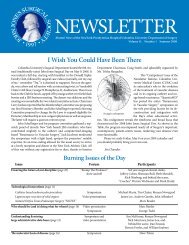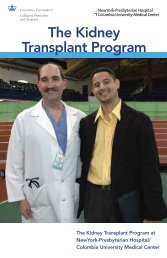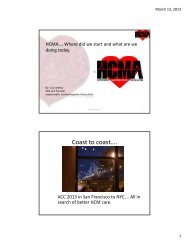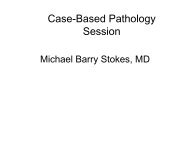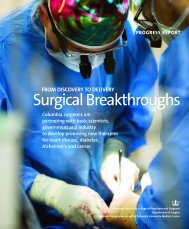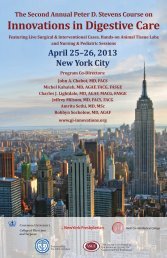NEWSLETTER - Columbia University Department of Surgery
NEWSLETTER - Columbia University Department of Surgery
NEWSLETTER - Columbia University Department of Surgery
Create successful ePaper yourself
Turn your PDF publications into a flip-book with our unique Google optimized e-Paper software.
prolonged procedures that are typically required in complex reconstructions.<br />
The “Ten Commandments,” that Millard had construed<br />
from Gillies’ admonitions after his first visit have morphed into “16<br />
Principles <strong>of</strong> Plastic <strong>Surgery</strong>.” 7 The writing style is colloquial with droll<br />
adaptations <strong>of</strong> literary metaphors. Acronyms like “P.A.W.G.” (postauricular<br />
Wolfe Graft) appearing without an introduction and frequent<br />
use <strong>of</strong> playful slang can be both puzzling and irritating. 8 Drawings,<br />
doodles, cartoons, and collages, including cut-outs <strong>of</strong> Gillies pasted<br />
into actual case photos, adorn some pages as stress abating diversions<br />
in the midst <strong>of</strong> so many challenging injuries.<br />
Webster was at the peak <strong>of</strong> his career at age 69, had known<br />
Gillies since 1926, and was aware <strong>of</strong> both authors’ foibles when he<br />
reflected on their collaboration in his foreword: “It must have been<br />
a very great pleasure for the senior author, and a valuable experience<br />
for the junior author, to look back …over patients who had been<br />
marvelously transformed from horribly deformed individuals to<br />
comparatively normal human beings.” He went on to express awe for<br />
Gillies’ ingenious flap designs, grafting, and facial reconstructions <strong>of</strong><br />
World War I burn and blast injuries. He recalled being shown a “soldier<br />
[Gillies] had reconstructed, whose entire lower jaw and mouth,<br />
including the mucous membrane, had been shot away… I was astonished<br />
to see the vermilion-colored lower lip and asked…where that<br />
tissue came from. The solider [undid] his tunic and showed his surprisingly<br />
bright-red, suprasternal skin, which had been… utilized so<br />
effectively in [its new] position.”<br />
Left panel: Darryl Lindsay watercolor <strong>of</strong> patient when first seen in November<br />
1918; right panel, appearance in June 1924, adapted from. 20<br />
Webster’s comments were those <strong>of</strong> a friend and colleague who<br />
had developed the first certified plastic surgery residency in the<br />
world. 9 He was a founding member and past chairman <strong>of</strong> the American<br />
Board <strong>of</strong> Plastic <strong>Surgery</strong>, former President or Vice President <strong>of</strong><br />
multiple plastic surgical societies and was about to be honored for<br />
his personification <strong>of</strong> excellence in the teaching and performance<br />
<strong>of</strong> plastic surgery. 10,11 Webster was not a prolific writer <strong>of</strong> technical<br />
articles, but published descriptions <strong>of</strong> giant thoraco-epigastric tube<br />
flaps, refrigerated skin grafts, the use <strong>of</strong> the temporalis muscle for<br />
the coverage <strong>of</strong> orbital defects after exenteration, and management<br />
<strong>of</strong> a bifid nose. 12,13 He was more inclined to write about his heroes<br />
and colleagues, notably John Staige Davis, Arturo Castiglioni, Vilray<br />
Papin Blair, S. Milton Dupertuis (his first certified program resident),<br />
Harold Gillies and Gaspare Tagliacozzi. 14–19<br />
Automated weapon bullets, shrapnel, and massive burns from<br />
trench warfare and military plane crashes decimated the s<strong>of</strong>t tissue<br />
and bony structures <strong>of</strong> thousands <strong>of</strong> soldiers. Eyes, noses, jawbones,<br />
John Jones Surgical Society Volume 13, Number 2 Winter 2010<br />
Presentation <strong>of</strong> a Special Honorary Citation by President, Wallace<br />
H. Steffensen at the American Society <strong>of</strong> Plastic and Reconstructive<br />
<strong>Surgery</strong>’s 1958 Annual Meeting in Chicago. 11<br />
oral cavities, and ears went missing or were melted or mangled beyond<br />
recognition. 20 In the summer <strong>of</strong> 1916, the reconstructive unit<br />
that Gillies created at Queen Mary’s Hospital, Sidcup received 2000<br />
cases in 10 days from the battle at Somme and performed over 11,000<br />
reconstructive procedures from 1916 through 1925. 21 During this<br />
time certain benches in the parks <strong>of</strong> Sidcup were painted blue both<br />
as a code reserving them for disfigured soldiers and a warning to civilians<br />
<strong>of</strong> the possibility <strong>of</strong> encountering a mutilated human being. 22<br />
The Plastic Theatre, Queen Mary’s Hospital, 1917. Gillies seated on the right. 25<br />
John Staige Davis noted that World War I did not create the<br />
field <strong>of</strong> plastic surgery as is commonly misunderstood, “as a matter<br />
<strong>of</strong> fact, little advance was made in the principles <strong>of</strong> plastic surgery,”<br />
but it did stimulate a more widespread interest in the field as a distinct<br />
entity and accelerated its advances and organization. 23<br />
Gillies died in London in 1960 after refreshing his heritage<br />
with a visit to New Zealand. 24 The Principles and Art <strong>of</strong> Plastic <strong>Surgery</strong><br />
proved to be durable and can be found on the active shelves <strong>of</strong><br />
most medical center libraries. John Jones Surgical Society member,<br />
Blair Rogers (1923-2006) 25 , the founding editor <strong>of</strong> Aesthetic Plastic<br />
<strong>Surgery</strong> and a notable student <strong>of</strong> medical history, observed in 1996<br />
that: “… there was almost nothing in the art <strong>of</strong> plastic surgery that<br />
had not been wonderfully and colorfully described in this two-volume<br />
masterpiece by Gillies and Millard.”<br />
Why Webster? Read on, there is much more to the story!<br />
References:<br />
1. Ivy RH. Some circumstances leading to organization <strong>of</strong> the American Board <strong>of</strong><br />
Plastic <strong>Surgery</strong>. Plast Reconstr Surg 1955;10:77-85.<br />
3



